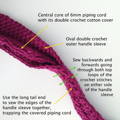How to Crochet a Bag: A Comprehensive Guide + Free Patterns

Crochet bags are the new trend and are quickly replacing plastic bags for grocery errands or handbags in streetwear. They’re incredibly versatile too, allowing you to design your own bag to suit different uses, whether you want one to bring to the beach or one to hold your buys at your local farmer’s market.
Crocheting bags is a necessary next step in your crochet journey — a practical project that all crafters get into at some point. If you’re ready to crochet your first bag, you’ve come to the right place. In this article, we provide you with a comprehensive guide to crocheting bags plus some free patterns you can use to guide you!
Choosing the Right Yarn and Hook
The most important first step in any crochet project is choosing the right yarn and hook size. Each type or weight of yarn will call for a different hook size, and getting it right is the key to achieving your intended design and the durability of your project.
Let’s start with choosing the right yarn. The yarn you should use is highly dependent on the bag design you’re going to make and its intended use. Are you making a backpack, market bag, tote, or crossbody bag? Do you want your bag to be lacy and open, or do you want a little more protection for your belongings? How tight do you want your stitches to be?
All this plays a role in finding the best yarn for your crochet bag. A general rule of thumb is to find a yarn type that is durable, making for a stronger and long-lasting crochet bag you can use for years to come. Yarn with natural fibers like cotton is the most popular option for crochet bags because of its durability.
Now let’s find the right hook size. While beginners often use a single hook for all their projects, you’re going to need a selection as you advance in your hobby. Your hook size will influence your stitch pattern — a larger hook creates looser stitches while a smaller hook makes tighter and denser stitches.
The right hook size will also depend on the type of yarn you’re using. The consensus is that the thicker your yarn is, the larger your hook size should be. Some yarn brands will tell you what hook size is recommended, and crochet bag patterns will also suggest the most suitable hook size. To give you an overview, though, here’s a quick cheat sheet:




